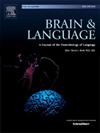在音乐鸡尾酒会上,注意力、音乐性和熟悉度塑造了大脑皮层的言语追踪
IF 2.3
2区 心理学
Q1 AUDIOLOGY & SPEECH-LANGUAGE PATHOLOGY
引用次数: 0
摘要
“鸡尾酒会问题”挑战我们在嘈杂环境中理解语言的能力,通常包括背景音乐。在这里,我们探讨了背景音乐在噪音听力中的作用。参与者一边听一本熟悉和不熟悉音乐的有声读物,一边追踪演讲或歌词中的关键词。我们用脑电图来测量对有声读物的神经跟踪。当语音被音乐掩盖时,模拟的时间响应函数(TRF)在50 ms时的峰值延迟(P1TRF)比未被掩盖时延长。此外,在不熟悉的背景音乐中,P1TRF振幅更大,表明语音跟踪得到了改善。我们观察到在100毫秒(N1TRF)时,当言语不是被注意的刺激时,延迟延长,尽管只有在不太喜欢音乐的听众中。我们的研究结果表明,语音的早期神经表征在注意和同时播放不熟悉的音乐时都更强,这表明熟悉的音乐更容易分散注意力。一个人在鸡尾酒会上感知过滤“音乐噪音”的能力也取决于客观的音乐聆听能力。本文章由计算机程序翻译,如有差异,请以英文原文为准。
Attention, musicality, and familiarity shape cortical speech tracking at the musical cocktail party
The “cocktail party problem” challenges our ability to understand speech in noisy environments and often includes background music. Here, we explored the role of background music in speech-in-noise listening. Participants listened to an audiobook in familiar and unfamiliar music while tracking keywords in either speech or song lyrics. We used EEG to measure neural tracking of the audiobook. When speech was masked by music, the modeled temporal response function (TRF) peak latency at 50 ms (P1TRF) was prolonged compared to unmasked. Additionally, P1TRF amplitude was larger in unfamiliar background music, suggesting improved speech tracking. We observed prolonged latencies at 100 ms (N1TRF) when speech was not the attended stimulus, though only in less musical listeners. Our results suggest early neural representations of speech are stronger with both attention and concurrent unfamiliar music, indicating familiar music is more distracting. One’s ability to perceptually filter “musical noise” at the cocktail party also depends on objective musical listening abilities.
求助全文
通过发布文献求助,成功后即可免费获取论文全文。
去求助
来源期刊

Brain and Language
医学-神经科学
CiteScore
4.50
自引率
8.00%
发文量
82
审稿时长
20.5 weeks
期刊介绍:
An interdisciplinary journal, Brain and Language publishes articles that elucidate the complex relationships among language, brain, and behavior. The journal covers the large variety of modern techniques in cognitive neuroscience, including functional and structural brain imaging, electrophysiology, cellular and molecular neurobiology, genetics, lesion-based approaches, and computational modeling. All articles must relate to human language and be relevant to the understanding of its neurobiological and neurocognitive bases. Published articles in the journal are expected to have significant theoretical novelty and/or practical implications, and use perspectives and methods from psychology, linguistics, and neuroscience along with brain data and brain measures.
 求助内容:
求助内容: 应助结果提醒方式:
应助结果提醒方式:


